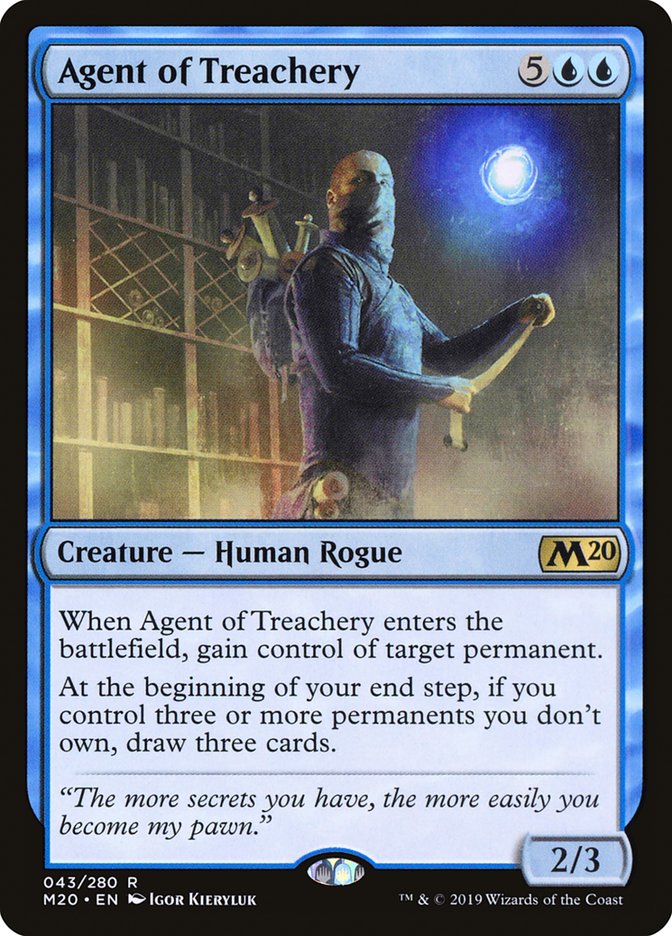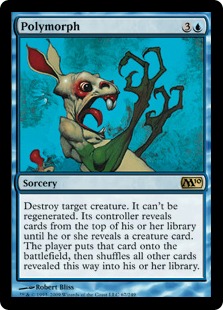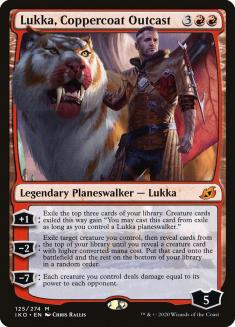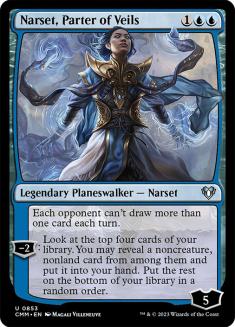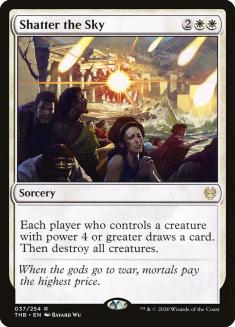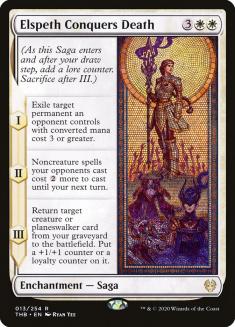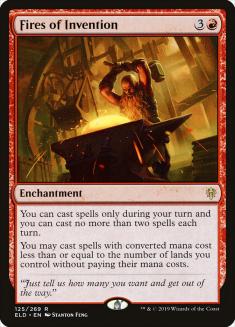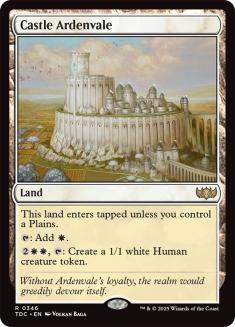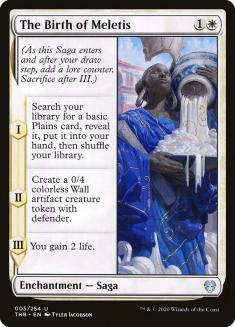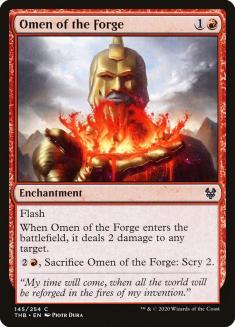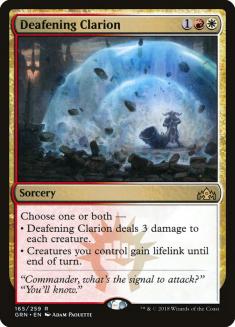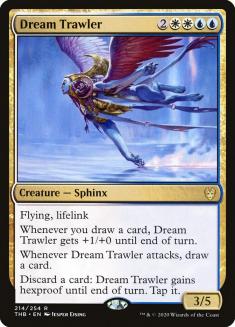Nothing says “We have solved for the best deck in Standard” quite like Prerelease Weekend, right?
Uh…right?
Well, with cards hitting the digital world faster than ever before, formats end up developed before cardboard hits the shelves. It makes for a heightened sense of buyer confidence, knowing that the cards you’re pre-ordering have been proven in Standard.
Without further ado, here’s the stock version of Yorion Jeskai Lukka:
Creatures (4)
Planeswalkers (13)
Lands (36)
Spells (27)

There’s a lot going on here, so let’s start off with the primary draw to the deck:
Throughout its time in Standard, Agent of Treachery has been the most powerful thing to do in the format — from stealing Field of the Dead to being the best way to proactively deal with Fires of Invention and Nissa, Who Shakes the World. Yorion Jeskai Lukka just so happens to be the best deck at abusing Agent of Treachery.
Historically, the card Polymorph has been used in conjunction with tokens in order to create a way for a four-mana card to immediately turn into something like Emrakul, the Aeons Torn. Now, Lukka gets to play the role of a Polymorph for five mana, with a free Polymorph the following turn. Pretty great in a deck that has guaranteed access to a creature that can be Polymorphed without ever taking up space in the library.
Luckily, Lukka and Yorion both create incentives with cards that can play reactively and turn a corner when their controllers are advantaged:
What this means is that the deck has a reasonable Plan B for the games where a Lukka isn’t drawn. Having a backup plan is particularly important in a deck that, by default, is required to play 80 cards.
What allows something as decidedly mopey as the tokens plan to be a real strategy is the fact that this deck can simply play the Azorius Control package that’s existed for a year or so now. The fact that this deck can’t really play creatures other than Agent of Treachery just makes Narset, Parter of Veils a budget-conscious version of Dig Through Time.
Finally, this deck is somehow a Fires of Invention deck as well. I guess it’s easy to fit everything in a deck with an additional twenty cards of compulsory real estate on the decklist sheet. Unlike more traditional versions of Jeskai Fires, this deck is less reliant on the enchantment — it just kicks it into overdrive when it does have it.
Yorion, in particular, is incredible at powering through the limitations of Fires of Invention. That’s to say if Yorion is simply the second spell cast off Fires, it can exile the Fires, leaving Yorion’s controller with a bunch of untapped mana to continue casting spells with.
Considering this deck has so many ways to blink, bounce, cast, and Polymorph copies of Agent of Treachery onto the battlefield, it’s hard for decks to present anything substantial that can’t simply be stolen. Conceptually, it’s possible to beat up on what Yorion’s doing, and Michael Majors even wrote about it a bit on Tuesday, but in the time since it being discovered, the deck has had a shockingly high win-rate.
Playing the Deck
Like many things in Ikoria Standard, most of the lines of play in the deck are meant to aim the direction of utilizing a core of key cards. That’s to say developing Narset before Teferi, Time Raveler on Turn 3 is going to be great in games where there isn’t much in the way of pressure from the opponent and there isn’t a Lukka or Fires of Invention in sight. Against decks that may have countermagic, developing Teferi is going to be better because it paves the way for the aforementioned cards to take over the game.
That specific decision is fairly basic, but it segues into the mentality of checking boxes in order to implement a specific combo. In this deck, the boxes that need to be checked are as follows:
Playing Lands
As with any control deck, hitting the first five land drops is important. I know this sounds obvious, but the first step in getting a combo together is making sure the cards are there to cast them. This means that the first priority with card selection spells is doing what needs to be done to make sure that lands are entering the battlefield on time.
This means that it can change the order spells are meant to be cast because some cards are going to increase the odds of hitting lands and some aren’t. Teferi, for example, is going to be a better Turn 3 play than something like Omen of the Sun because the tokens are less relevant than the land drops.
Decks that spin their wheels and generate a bunch of material in hand, with the likes of Omen of the Sea and Narset, are very rarely going to run out of things to do with their mana. That means placing a heavy emphasis on hitting land drops is necessary. To be a bit anecdotal for the sake of making a point, I’ve cycled Raugrin Triome twice in two days of playing the deck.
Have a Lukka, Coppercoat Outcast
This one is a bit more obvious, but this is the “one-card combo” of sorts. Prioritizing finding a copy of Lukka should follow prioritizing land drops. This is because the lands are what enable the deck to actually develop Lukka and make use of it.
What Lukka is prioritized over, however, is:
Have a Creature
Having a creature in this deck is so easy that it will frequently just happen. Seriously, there are a lot of cards that make creatures:
This group of token-producers doesn’t even get into the fact that there’s always a creature hiding out in the (don’t say command zone, don’t say command zone) command zone. Er, companion zone? Sideboard? You get it.
In any synergy deck, sequencing cantrips and draw spells frequently comes down to prioritizing things like this and serves as a useful framework for decks trying to utilize anything resembling a combo.
Sideboarding
With a deck like Yorion Jeskai Lukka, sideboarding is a matter of figuring out which section of the deck is ineffective and going from there. The deck being 80 cards makes it harder to really justify playing a spattering of one- and two-of cards in the sideboard. It’s so unlikely that the cards will be drawn in a timely fashion that it’s simply going to be better to be able to morph entire packages to be better in a specific matchup. For example:
VS Mono-Red Aggro
Out:
In:
On the surface, it’s easy to write off this sort of sideboard plan as “cheap cards out, removal in,” but that isn’t the whole story. Worth nothing are the kinds of cards that are being taken in and out:
Narset, Shark Typhoon, and Agent of Treachery are all tools that are used to win an arms race. That’s not part of the plan against Mono-Red Aggro, because, well, they aren’t trying to fight that fight. Presumably, sweepers and Dream Trawler will be able to go over the top of Scorch Spitter and friends.
The difference is that Dream Trawler and sweepers are better while behind. Shark Typhoon will struggle to do anything worthwhile before the card that it answers has already gotten its value. Narset will do very close to nothing. Agent of Treachery is a seven-mana 2/3 that steals something that costs three mana?
These aren’t the parts of the deck that are good against Mono-Red Aggro. When sideboarding by painting broad strokes, recognizing the parts of the deck’s gameplan that don’t fit in a matchup is crucial.
Yorion, in particular, will force this sort of thinking when creating plans because it doesn’t increase the size of the sideboard with the size of the maindeck. This means less seasoning to taste and more plan optimization.
VS Boros Cycling
Out:
In:
One of the most important skills one can learn when sideboarding with these strategies is when it’s time to completely abandon a plan. Against Mono-Red Aggro, Lukka stayed in because it was a way to crank out Dream Trawler ahead of schedule. Against a deck with Flourishing Fox, an X/5 lifelink creature isn’t going to be as effective, so the incentive for having cards with as low a ceiling as Lukka is greatly reduced.
The plan here is much more to out-grind the opponent and check the threats that they do present. The first Zenith Flare is usually beatable. The second one isn’t.
Narset is a hate card against cycling variants. It isn’t always correct to automatically roll her down when she hits the battlefield, since having a five-loyalty planeswalker that turns off the opponent’s strategy is better than a three-loyalty planeswalker that draws a card. That goes double when considering that cycling can simply attack Narset down without much trouble. Protect her to make games against cycling far more manageable.
In spite of the fact that Flourishing Fox can grow to a substantial size, there isn’t actually anything that reasonable for Agent of Treachery to steal. Most of the cards in the cycling variants are synergy pieces that don’t work once stolen, and Agent of Treachery looks much worse when it’s a fancy Ravenous Chupacabra.
This is the main matchup where Omen of the Forge being a Shock instead of a Lightning Strike is rough. Being on the draw against Flourishing Fox makes it impossible for Omen of the Forge to kill it, and the number of taplands in the deck can create situations where Omen of the Forge isn’t even good enough on the play. If Boros/Jeskai Cycling becomes more prevalent throughout the season, changing Omen of the Forge to Scorching Dragonfire or Fire Prophecy would make a ton of sense.
While it isn’t great at checking Flourishing Fox, Dream Trawler does do a great job of creating a nice buffer of life against opposing copies of Zenith Flare. Two attacks are likely to undo an entire copy of one of their finishers, and any more attacks from Trawler will put Boros Cycling more in a space of “Zenith to stay alive” rather than “Zenith to kill.”
VS Yorion Jeskai Lukka
Out:
In:
This illustrates one of the sadder realities of some mirrors: being on the play is an incredible advantage because the only real fight being fought is developmental.
In blue mirrors, Mystical Dispute is the best tool by such a wide margin that it pushes out most of the other Negate-esque effects that would see play. This creates a paradigm seen previously with Mana Leak where being on the play means that one player will be a hair better at operating in the face of opposing Mana Leaks.
Being able to develop a Turn 4 Teferi with Mystical Dispute backup for an opposing Mystical Dispute is absolutely backbreaking in most contexts.
The emphasis being placed on Agent of Treachery severely limits the number of tools that can be brought in for the mirror — Legion Warboss and the like just hurt Lukka, after all. This limitation is a direct result of just how good the deck is at abusing Agent of Treachery, even when the card is simply acting as repeated copies of Annex.
Most sideboarding with these decks will come down to recognizing the fight in the matchup — be it creatures, grinding, or a race to Agent of Treachery. This recognition helps determine what cards are filler, which ones aren’t worth a draw step, and what pieces of the puzzle are most important. The lesson we learn from sideboarding with this deck will carry throughout Yorion’s time in Standard.
Assuming it remains legal, of course…


